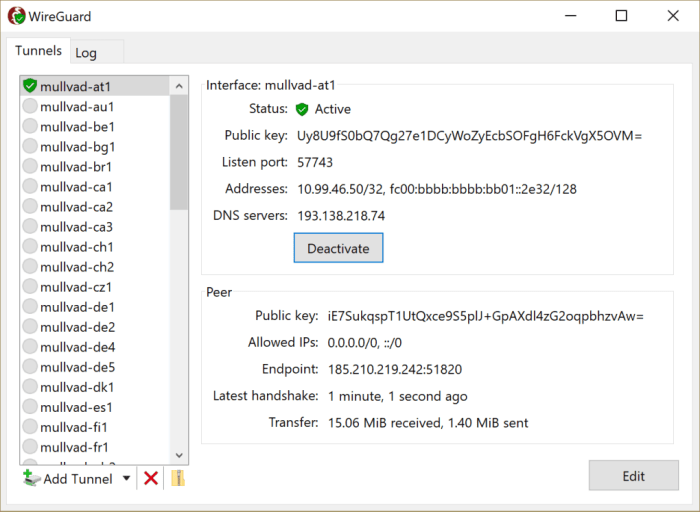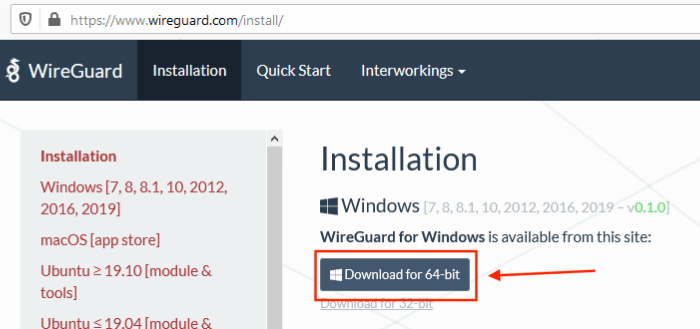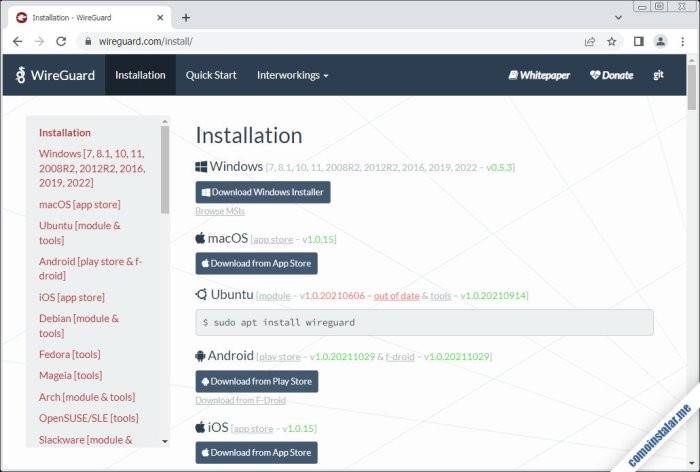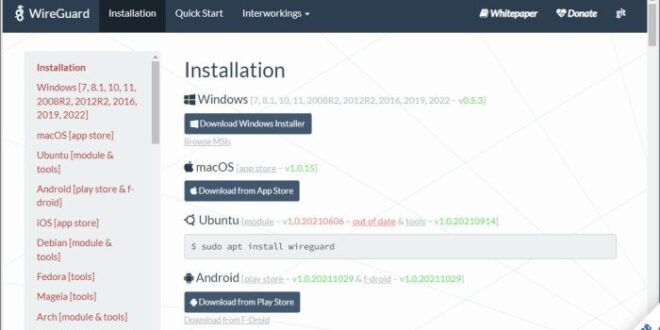In today’s digital age, protecting our online privacy and security is paramount. Virtual Private Networks (VPNs) have emerged as a powerful tool to safeguard our data and maintain anonymity while browsing the internet. Among the various VPN protocols available, WireGuard stands out as a cutting-edge solution that offers unparalleled speed, security, and ease of use.
This comprehensive guide will delve into the world of WireGuard, providing you with everything you need to know about downloading, installing, configuring, and using this exceptional VPN protocol. Whether you’re a seasoned network professional or a novice user seeking to enhance your online security, this guide will empower you with the knowledge and skills to harness the full potential of WireGuard.
Introduction
WireGuard is a modern, fast, and secure VPN tunnel that utilizes state-of-the-art cryptography and a simple, easy-to-audit codebase. Its primary goal is to provide a secure and reliable way to establish virtual private networks (VPNs) with minimal overhead and configuration complexity.WireGuard
operates by establishing a secure tunnel between two or more devices, encrypting all traffic passing through it. This encrypted tunnel ensures that data remains confidential and protected from eavesdropping or interception. WireGuard’s efficient design allows for high-speed connections and low latency, making it suitable for various applications, including secure remote access, private network connectivity, and bypassing censorship or geographical restrictions.
Key Features
-
-*Strong Encryption
WireGuard employs robust encryption algorithms, such as ChaCha20 and Curve25519, to protect data from unauthorized access.
-*Simplicity and Ease of Use
WireGuard’s codebase is designed to be straightforward and easy to understand, facilitating quick setup and configuration.
-*Cross-Platform Compatibility
WireGuard is compatible with various operating systems, including Windows, Linux, macOS, Android, and iOS, ensuring widespread accessibility.
-*Open Source and Free
WireGuard is open-source software, freely available for use and modification, fostering transparency and community contributions.
Installing WireGuard
WireGuard installation involves a few straightforward steps, varying slightly across operating systems.
Windows
- Download the WireGuard installer from the official website.
- Run the installer and follow the on-screen instructions.
- Once installed, launch WireGuard and create a new tunnel.
macOS
1. Install Homebrew package manager
“`/bin/bashc “$(curl
-fsSL https
//raw.githubusercontent.com/Homebrew/install/HEAD/install.sh)”
“`
2. Install WireGuard using Homebrew
“`brew install wireguard-tools“`
3. Create a new tunnel using the following command
“`wg-quick up mytunnel“`
Linux
1. Install WireGuard using your distribution’s package manager
Debian/Ubuntu
“`sudo apt-get install wireguard“`
Fedora/CentOS
“`sudo dnf install wireguard-dkms“`
Arch Linux
“`sudo pacman
S wireguard-tools
“`
2. Create a new tunnel using the following command
“`wg setconf mytunnel /etc/wireguard/mytunnel.conf“`
Configuring WireGuard
WireGuard provides several configuration options to customize its behavior. These options can be specified in a configuration file, typically named `wg0.conf`, which is read by the WireGuard service when it starts.The configuration file consists of a series of key-value pairs, where the key specifies the option name and the value specifies the option value.
The following table lists some of the most common configuration options:| Option | Description ||—|—|| `PrivateKey` | The private key for the WireGuard interface. || `Address` | The IP address of the WireGuard interface. || `ListenPort` | The port number on which the WireGuard interface listens for connections.
|| `AllowedIPs` | A list of IP addresses that are allowed to connect to the WireGuard interface. || `Endpoint` | The public IP address or hostname of the remote WireGuard peer. || `PresharedKey` | A shared secret that is used to authenticate connections to the WireGuard interface.
|Here is an example of a WireGuard configuration file:“`[Interface]PrivateKey = 0123456789abcdef0123456789abcdef01234567Address = 10.0.0.1/24ListenPort = 51820AllowedIPs = 10.0.0.2/32[Peer]Endpoint = 192.168.1.1:51820PublicKey = 0123456789abcdef0123456789abcdef01234567PresharedKey = 0123456789abcdef0123456789abcdef01234567“`This configuration file creates a WireGuard interface with the IP address 10.0.0.1 and listens for connections on port 51820. It allows connections from the IP address 10.0.0.2 and connects to a remote WireGuard peer with the public IP address 192.168.1.1 and port 51820. The remote peer’s public key is 0123456789abcdef0123456789abcdef01234567, and the shared secret is 0123456789abcdef0123456789abcdef01234567.
Connecting to a WireGuard Server
Connecting to a WireGuard server requires the client to have the server’s public key and the shared private key. The server also needs the client’s public key.
To connect to a WireGuard server, follow these steps:
- Generate a new key pair on the client device.
- Send the client’s public key to the server administrator.
- The server administrator will generate a new key pair and send the server’s public key to the client.
- The client imports the server’s public key into their WireGuard configuration.
- The client connects to the WireGuard server using the shared private key and the server’s public key.
Peer and Endpoint
In the WireGuard configuration, the server is referred to as a “peer” and the client is referred to as an “endpoint”. The peer section contains the server’s public key and the endpoint section contains the client’s private key.
Troubleshooting WireGuard
WireGuard is a robust and reliable VPN solution, but like any software, it can occasionally encounter issues. Here are some common problems and solutions to help you troubleshoot WireGuard:
Common Errors and Issues
*
-*Connection refused
This error occurs when the WireGuard server is not running or is not listening on the specified port. Ensure that the server is running and that the port is open in the firewall.
-
-*Handshake failed
This error indicates that the client and server cannot establish a secure connection. Check if the public keys are correct and that the endpoints are configured properly.
-*IP address conflict
If you encounter an IP address conflict, it means that the IP address assigned to the WireGuard interface is already in use by another device. Change the IP address assigned to the WireGuard interface to resolve the conflict.
-*DNS resolution issues
WireGuard relies on DNS to resolve hostnames. If you encounter DNS resolution issues, ensure that the DNS settings are configured correctly on the client and server.
-*Performance issues
Poor performance can be caused by various factors, such as network congestion, high latency, or inefficient routing. Optimize network settings, reduce latency, and ensure that the routing is efficient to improve performance.
Solutions and Workarounds
*
-*Connection refused
Start the WireGuard server and open the specified port in the firewall.
-
-*Handshake failed
Verify the public keys and ensure that the endpoints are configured correctly.
-*IP address conflict
Change the IP address assigned to the WireGuard interface.
-*DNS resolution issues
Configure the DNS settings correctly on the client and server.
-*Performance issues
Optimize network settings, reduce latency, and ensure efficient routing.
Security Considerations
WireGuard is a secure VPN protocol that uses strong encryption algorithms to protect your data from eavesdropping and interception. It also includes several security features, such as perfect forward secrecy, to ensure that your data remains confidential even if the server’s private key is compromised.
Encryption Protocols and Algorithms
WireGuard uses the following encryption protocols and algorithms:
- ChaCha20 stream cipher
- Poly1305 message authentication code (MAC)
- Curve25519 elliptic curve Diffie-Hellman (ECDH) key exchange
- BLAKE2s hash function
These algorithms are considered to be among the most secure available and provide strong protection against a variety of attacks.
Advanced Features
WireGuard boasts an array of advanced features that elevate its functionality and versatility. These features include roaming, multiplexing, and NAT traversal, each contributing to enhanced performance and adaptability.
Roaming
Roaming enables seamless connectivity as devices transition between different networks, such as Wi-Fi and cellular data. WireGuard automatically re-establishes the VPN connection without any noticeable interruption, ensuring uninterrupted access to protected resources.
Multiplexing
Multiplexing allows multiple connections to share a single UDP port. This feature optimizes network utilization, reduces latency, and enhances performance, especially in scenarios with high traffic loads.
NAT Traversal
NAT traversal enables WireGuard to establish connections even when devices are behind Network Address Translation (NAT) firewalls. This feature ensures compatibility with a wider range of network configurations, facilitating secure remote access and inter-network communication.
WireGuard vs. Other VPN Protocols
WireGuard is a modern VPN protocol that offers several advantages over other popular protocols such as OpenVPN and IPsec.WireGuard is significantly faster than both OpenVPN and IPsec, especially on low-powered devices. This is because WireGuard uses a simpler and more efficient encryption algorithm called ChaCha20, while OpenVPN and IPsec use more complex and computationally intensive algorithms.WireGuard
is also more secure than OpenVPN and IPsec. WireGuard uses a modern and well-audited cryptographic library, while OpenVPN and IPsec use older and less secure libraries. Additionally, WireGuard’s simpler design makes it less vulnerable to attack than OpenVPN and IPsec.Finally,
WireGuard is easier to configure than OpenVPN and IPsec. WireGuard’s configuration files are much simpler and easier to understand than OpenVPN and IPsec configuration files. This makes it easier to set up and manage a WireGuard VPN.
OpenVPN
OpenVPN is a well-established and widely used VPN protocol. It is known for its security and flexibility, and it is supported by a wide range of devices and platforms. However, OpenVPN is also relatively slow and complex to configure.
IPsec
IPsec is a suite of VPN protocols that is commonly used in corporate networks. IPsec is very secure, but it is also complex to configure and manage.
Applications of WireGuard

WireGuard’s unique features and capabilities make it a versatile tool for various applications, including:
- Remote Access: WireGuard can securely connect remote users to corporate networks, allowing them to access internal resources and applications as if they were on-site.
- Site-to-Site VPNs: WireGuard can establish secure connections between multiple locations or offices, enabling seamless data transfer and resource sharing.
- Cloud Connectivity: WireGuard can be used to create secure tunnels between on-premises networks and cloud platforms, providing secure access to cloud services and applications.
- IoT Security: WireGuard can secure communications between IoT devices and cloud platforms, ensuring data privacy and integrity.
- Personal Privacy: WireGuard can be used by individuals to protect their online privacy and bypass internet censorship, providing secure and anonymous access to the internet.
By utilizing WireGuard’s strong encryption, fast performance, and ease of configuration, organizations and individuals can enhance the security and privacy of their network communications in various scenarios.
Future of WireGuard

WireGuard is an open-source VPN protocol that has gained significant popularity due to its simplicity, performance, and security. As the project continues to develop, there are several exciting plans and potential use cases for WireGuard in the future.
One of the key areas of focus for WireGuard’s future development is expanding its capabilities for enterprise use. This includes features such as centralized management, user authentication, and support for complex network topologies. By addressing these enterprise needs, WireGuard aims to become a more comprehensive VPN solution for businesses and organizations.
Potential Use Cases and Applications
Beyond enterprise use, WireGuard has the potential to play a significant role in several other areas:
- Mobile VPNs: WireGuard’s lightweight and efficient design makes it well-suited for mobile devices, providing secure and reliable VPN connections on smartphones and tablets.
- IoT Security: As the Internet of Things (IoT) continues to grow, WireGuard can be used to secure communication between IoT devices, ensuring their privacy and data integrity.
- Cloud Computing: WireGuard can be used to establish secure tunnels between cloud-based services and on-premises networks, facilitating secure access to cloud resources.
- Network Isolation: WireGuard can be used to isolate different segments of a network, creating virtual private networks (VPNs) that are logically separated from each other.
These are just a few examples of the potential use cases and applications of WireGuard. As the project continues to evolve, it is likely that we will see even more innovative and creative ways to leverage WireGuard’s capabilities.
Last Point

WireGuard represents the future of VPN technology, offering a seamless blend of speed, security, and user-friendliness. Its simplicity and efficiency make it an ideal choice for individuals and organizations alike. As the world becomes increasingly interconnected, WireGuard will undoubtedly play a pivotal role in safeguarding our digital privacy and security.
Embrace the power of WireGuard today and experience the unparalleled benefits it offers.
